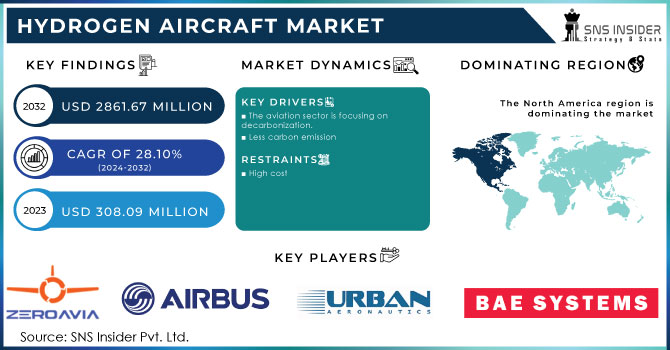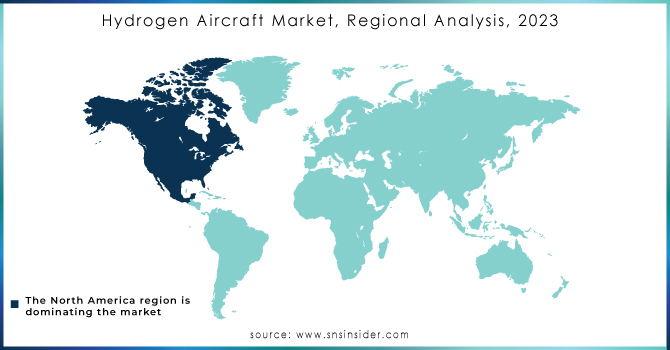Hydrogen Aircraft Market Report Scope & Overview:

To get more information on Hydrogen Aircraft Market - Request Free Sample Report
The Hydrogen Aircraft Market Size was valued at USD 308.09 million in 2023 expected to reach USD 2861.67 million by 2032 and grow at a CAGR of 28.10% over the forecast period 2024-2032.
A hydrogen aircraft is an aeroplane that is powered by hydrogen (liquid or gas). A hydrogen aeroplane can use hydrogen energy in two ways. It can be used in a jet engine or other types of internal combustion engines, or it can be used to power a fuel cell, which generates electricity to power an aircraft propeller. Hydrogen research as a potential fuel to power zero-emission aircraft has increased in recent years. The aviation industry is attempting to create technology to address issues such as hydrogen storage, public perceptions of safety, and cost.
MARKET DYNAMICS
KEY DRIVERS
-
The aviation sector is focusing on decarbonization.
-
Less carbon emission
RESTRAINTS
-
High cost
OPPORTUNITIES
-
Development of Hydrogen Aircraft
-
Minimum pollution
CHALLENGES
-
Converting current planes to hydrogen planes
-
Low temperature requirement
THE IMPACT OF COVID-19
With its rapid global spread, high mortality and closure, and border closure, COVID-19 has significantly reduced the need for worldwide travel. Indeed, COVID-19 is a shift in the tourism industry as a result of a combination of changes in passenger behavior, government travel restrictions, and widespread global economic decline. The corona-virus crisis also contributes to the impact of commercial aviation on climate change beyond reducing the emissions of canceled flights and suspended flights. Improvements in shipping efficiency and a significant increase in the use of sustainable aircraft fuels and hydrogen fuels may be delayed. Technological advances in the development and design of air-frames have contributed to many improvements in fuel efficiency and reduced emissions since the 1950's. NASA's programs in basic and operational research as well as the Federal Aviation Administration's technical development and education relationships with participating airlines continue and have the potential to significantly reduce CO2 and NO2 emissions from new generation aircraft. Many older, less efficient flights parked as part of the access will not be restored to service. In particular, however, the industry is expected to delay acquiring a new aircraft containing technological improvements until demand is met, solvency verification of carrier companies is guaranteed, and the price of aircraft fuel puts pressure on adding evolutionary fuel-saving evolution to ships.
The hydrogen aircraft market is divided into two segments based on power source: hydrogen combustion and hydrogen fuel cell. The expansion of the hydrogen fuel cell segment of the hydrogen aircraft market can be ascribed to its simplicity as well as the availability of a battery backup system. The hydrogen aircraft market is divided into three segments based on passenger capacity: up to four passengers, five to ten passengers, and more than ten passengers. Because of the development of numerous hydrogen aircraft prototypes, the market for up to four passengers is likely to increase at a faster CAGR.
The hydrogen aircraft market is divided into three categories based on range: up to 20 km, 20 km to 100 km, and more than 100 km. The segment of up to 20 kilometers is expected to account for the majority of the total. Drones are predicted to be widely used in the near future (by 2028), driving the growth of the market for up to 20 km segments.
Factors such as increased worldwide air passenger traffic, the high appropriateness of hydrogen as an aviation fuel, and lower greenhouse gas emissions by using hydrogen aircraft are expected to drive expansion in the global hydrogen aircraft market during the forecast period. The existing price gap between hydrogen and conventional jet fuel, on the other hand, is likely to stifle growth in the worldwide hydrogen aircraft market throughout the projection period. Furthermore, the creation of a green hydrogen ecosystem, proactive government activities toward hydrogen powered aircraft, and rise in hydrogen infrastructure development around the world provide profitable prospects for market expansion during the projection period.
KEY MARKET SEGMENTATION
By Passenger Capacity
-
Less Than 100
-
101 To 200
-
More Than 200
By Range
-
Short Haul
-
Medium Haul
-
Long Haul
By Application
-
Passenger Aircraft
-
Cargo Aircraft
By Power Source
-
Fully Hydrogen Powered Aircraft
-
Hybrid Electric Aircraft
-
Hydrogen Fuel Cell Aircraft
-
Liquid Hydrogen Aircraft
REGIONAL ANALYSIS
The market for hydrogen aircraft has been researched in North America, Europe, Asia Pacific, and the rest of the world. North America is expected to have the highest share of the worldwide market. During the forecast period, the Asia Pacific and Rest of the World areas are expected to increase slowly. Canada and The United States are major countries in this region. During the forecast period, the United States is expected to lead the North American hydrogen aircraft market. Various studies and advancements are being conducted by government and business institutes to investigate and commercialize hydrogen aviation systems.

Need any customization research on Hydrogen Aircraft Market - Enquiry Now
REGIONAL COVERAGE
-
North America
-
USA
-
Canada
-
Mexico
-
-
Europe
-
Germany
-
UK
-
France
-
Italy
-
Spain
-
The Netherlands
-
Rest of Europe
-
-
Asia-Pacific
-
Japan
-
south Korea
-
China
-
India
-
Australia
-
Rest of Asia-Pacific
-
-
The Middle East & Africa
-
Israel
-
UAE
-
South Africa
-
Rest of Middle East & Africa
-
-
Latin America
-
Brazil
-
Argentina
-
Rest of Latin America
-
KEY PLAYERS
The Major Players are ZeroAvia Inc, Airbus SE, HES Energy Systems, GKN Aerospace,Urban Aeronautics Ltd., Alisport Srl, BAE systems, URBAN AERONAUTICS LTD, Airspace Experience Technologies, Inc., and Other players.
| Report Attributes | Details |
|---|---|
| Market Size in 2023 | US$ 308.09 Million |
| Market Size by 2032 | US$ 2861.67 Million |
| CAGR | CAGR of 28.1% From 2024 to 2032 |
| Base Year | 2023 |
| Forecast Period | 2024-2032 |
| Historical Data | 2020-2022 |
| Report Scope & Coverage | Market Size, Segments Analysis, Competitive Landscape, Regional Analysis, DROC & SWOT Analysis, Forecast Outlook |
| Key Segments | • By Range (Short Haul (< 1000 Km), Medium Haul (1000-2000 Km), Long Haul (2000+ Km)) • By Passenger Capacity (Less Than 100, 101 To 200 And More Than 200) • By Power Source (Fully Hydrogen Powered Aircraft, Hybrid Electric Aircraft, Hydrogen Fuel Cell Aircraft and Liquid Hydrogen Aircraft) • By Application (Passenger Aircraft and Cargo Aircraft) |
| Regional Analysis/Coverage | North America (USA, Canada, Mexico), Europe (Germany, UK, France, Italy, Spain, Netherlands, Rest of Europe), Asia-Pacific (Japan, South Korea, China, India, Australia, Rest of Asia-Pacific), The Middle East & Africa (Israel, UAE, South Africa, Rest of Middle East & Africa), Latin America (Brazil, Argentina, Rest of Latin America) |
| Company Profiles | ZeroAvia Inc, Airbus SE, HES Energy Systems, GKN Aerospace,Urban Aeronautics Ltd., Alisport Srl, BAE systems, URBAN AERONAUTICS LTD, Airspace Experience Technologies, Inc. |
| DRIVERS | • The aviation sector is focusing on decarbonization. • Less carbon emission |
| RESTRAINTS | • High cost |

